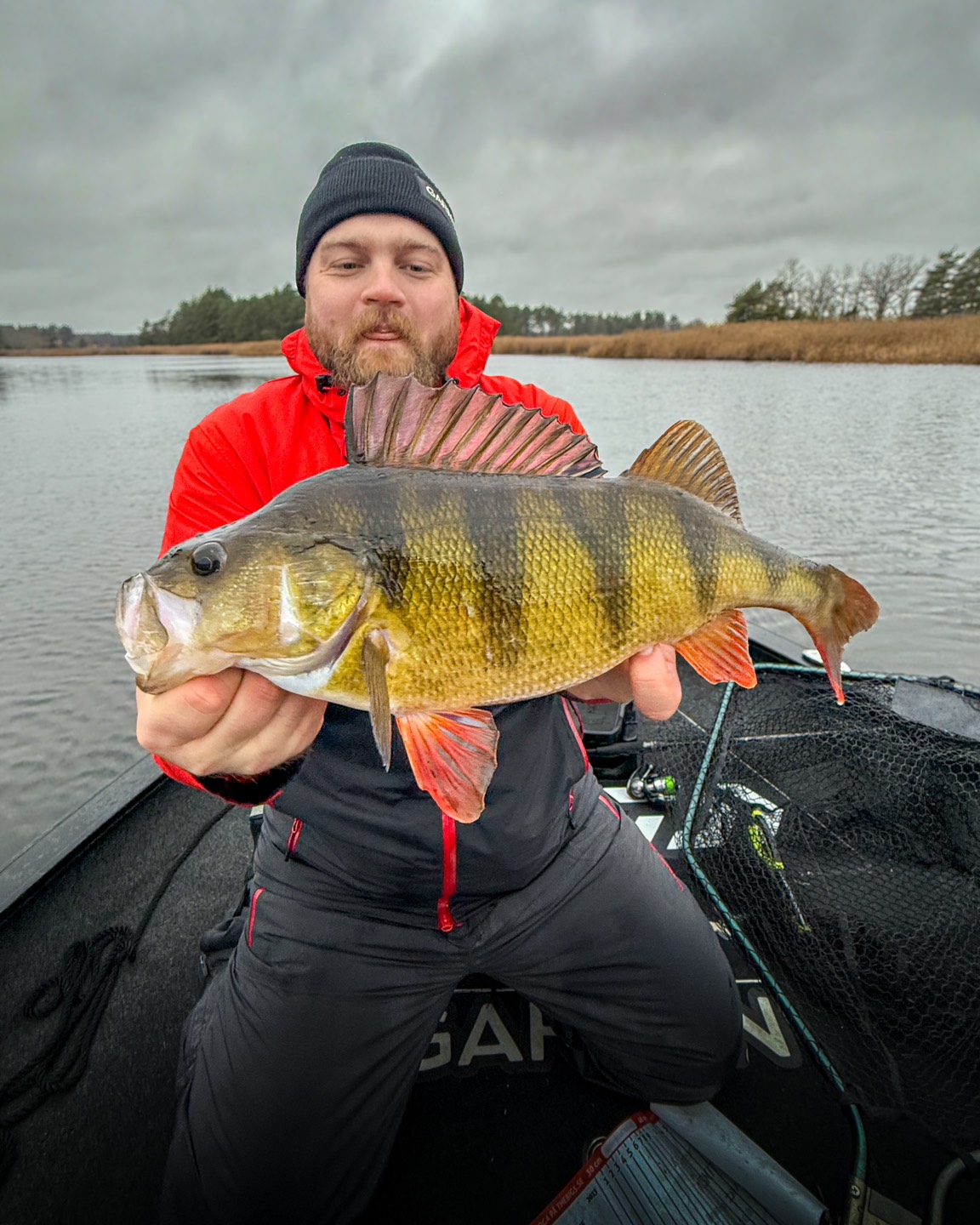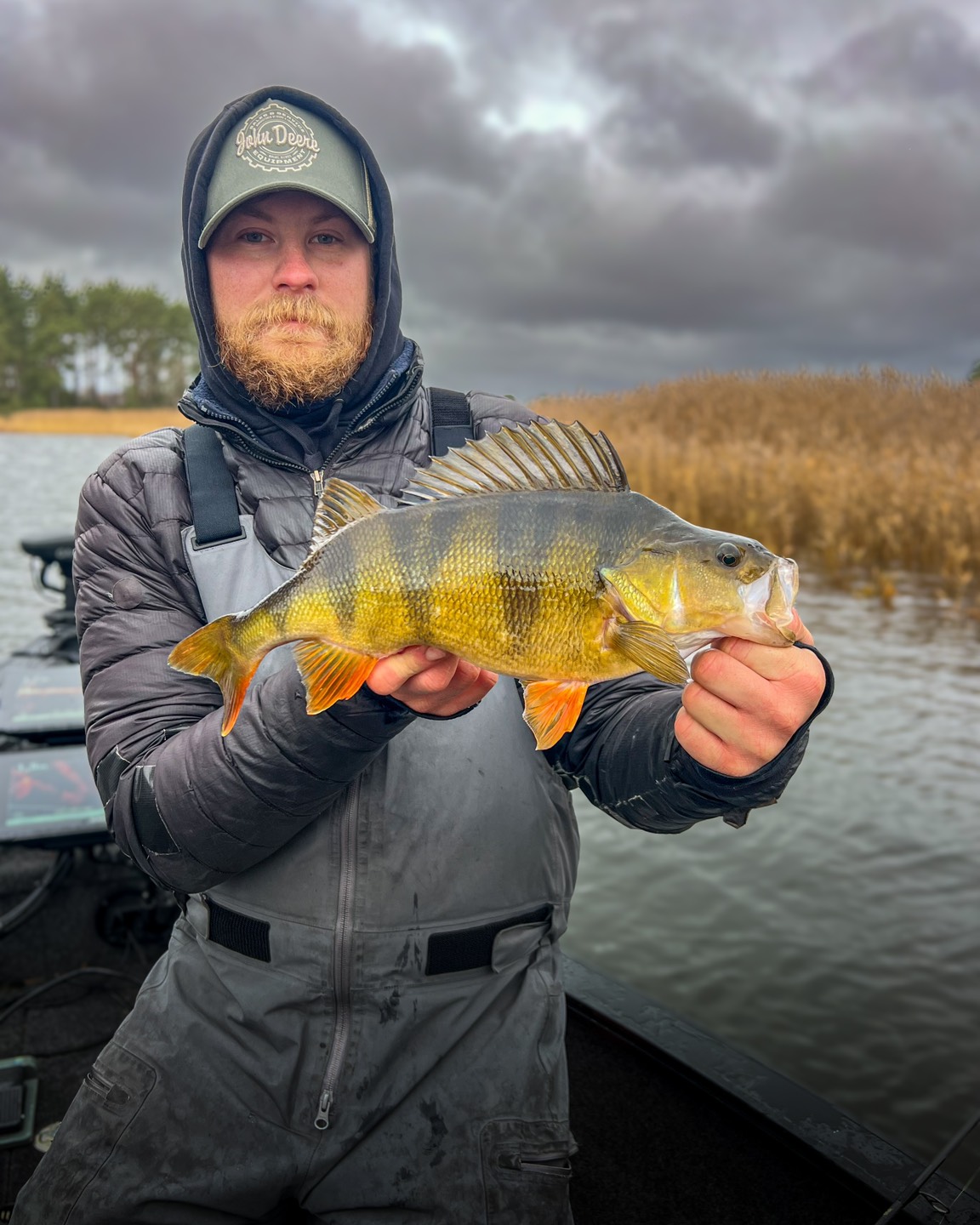HOT THIS MONTH
28.11.2024
Cold Water Perch Fishing: A Guide for Open Water Enthusiasts
Fishing for perch in cold water is a unique challenge that rewards patience, precision, and the right techniques. In Scandinavian waters, the predictability of perch movements during the colder months makes this a thrilling pursuit for anglers who know what to look for. Whether you’re fishing in lakes or the archipelago, understanding how perch behave as temperatures drop can significantly increase your chances of success.
Understanding Perch Behavior in Cold Water
As water temperatures fall, perch behavior changes dramatically, and these shifts vary between lakes and the archipelago. In lakes, perch tend to move deeper, following schools of baitfish as they seek out more stable conditions. Conversely, in the archipelago, perch often head shallower, congregating in predictable areas that are easier to locate.
This predictability is one of the reasons cold water perch fishing is so enjoyable. Once you’ve identified their likely locations, it’s a matter of waiting for their short, sporadic feeding windows. During these periods, big perch become active, providing the perfect opportunity to make a successful catch. My favorite water temperatures for targeting perch range from 3-7°C, although I’ve fished in conditions where the water was below freezing. Regardless of the temperature, knowing when and where to find feeding perch is half the battle.
This predictability is one of the reasons cold water perch fishing is so enjoyable. Once you’ve identified their likely locations, it’s a matter of waiting for their short, sporadic feeding windows. During these periods, big perch become active, providing the perfect opportunity to make a successful catch. My favorite water temperatures for targeting perch range from 3-7°C, although I’ve fished in conditions where the water was below freezing. Regardless of the temperature, knowing when and where to find feeding perch is half the battle.
Techniques for Success in Cold Water
When fishing for perch in cold water, slower is always better. As the temperature drops, the underwater environment becomes more sluggish, and your presentation should mimic this pace. Techniques that allow for long pauses—such as the Ned rig, drop shot, Carolina rig, or jerkbaits—are particularly effective.
For jerkbaits, my preferred cadence involves pauses of 5-10 seconds. These extended pauses give the perch time to inspect and strike, making this method particularly deadly when paired with suspending jerkbaits. Whether you’re fishing shallow in the archipelago or deep in a lake, keeping your movements deliberate and unhurried is key to success.
For jerkbaits, my preferred cadence involves pauses of 5-10 seconds. These extended pauses give the perch time to inspect and strike, making this method particularly deadly when paired with suspending jerkbaits. Whether you’re fishing shallow in the archipelago or deep in a lake, keeping your movements deliberate and unhurried is key to success.


Gear and Lures for Cold Water Conditions
Your choice of gear will depend on your technique, but high-quality equipment is essential for cold water fishing. Precision and sensitivity are critical when bites are subtle, so I rely on the Steez AGS rods and Prorex AGS rods.
When it comes to lures, minimal movement is the goal. During the winter months, everything underwater slows down, and your lure should reflect this natural pace. My go-to lures for cold water perch fishing include the Baitjunkie Minnow, Baitjunkie Risky Critter, and Slim Shady. The Baitjunkie lures not only excel in their subtle action but also feature floating Elastomax material that stands upright on the bottom during long pauses, creating an irresistible presentation.
The Slim Shady deserves special mention, thanks to its nearly 45-degree angled paddle tail, which produces a calm and subtle action that’s perfect for cold water conditions. This combination of design and material can often be the deciding factor in getting finicky winter perch to bit
When it comes to lures, minimal movement is the goal. During the winter months, everything underwater slows down, and your lure should reflect this natural pace. My go-to lures for cold water perch fishing include the Baitjunkie Minnow, Baitjunkie Risky Critter, and Slim Shady. The Baitjunkie lures not only excel in their subtle action but also feature floating Elastomax material that stands upright on the bottom during long pauses, creating an irresistible presentation.
The Slim Shady deserves special mention, thanks to its nearly 45-degree angled paddle tail, which produces a calm and subtle action that’s perfect for cold water conditions. This combination of design and material can often be the deciding factor in getting finicky winter perch to bit
Common Mistakes and Practical Tips
The most common mistake anglers make when targeting perch in cold water is fishing too fast. Impatience often leads to missed opportunities, as perch are unlikely to chase fast-moving prey in frigid conditions.
Another overlooked aspect is line monitoring. Subtle bites can be difficult to detect, so it’s crucial to watch your line constantly. Pairing this vigilance with premium gear, like the Steez AGS Lightning, ensures you’ll feel even the slightest nibble.
Cold water perch fishing in Scandinavian waters is a test of skill, patience, and knowledge. By understanding how perch behave, mastering slow techniques, and using high-quality gear like the Steez AGS Lightning and lures like the Slim Shady, you can turn the challenge of winter fishing into an unforgettable experience.
Another overlooked aspect is line monitoring. Subtle bites can be difficult to detect, so it’s crucial to watch your line constantly. Pairing this vigilance with premium gear, like the Steez AGS Lightning, ensures you’ll feel even the slightest nibble.
Cold water perch fishing in Scandinavian waters is a test of skill, patience, and knowledge. By understanding how perch behave, mastering slow techniques, and using high-quality gear like the Steez AGS Lightning and lures like the Slim Shady, you can turn the challenge of winter fishing into an unforgettable experience.
HOT THIS MONTH BACK NUMBER
18.12.2024
Introducing Team Daiwa Ice Fishing Rods: Designed for Scandinavian Winters
28.11.2024
Cold Water Perch Fishing: A Guide for Open Water Enthusiasts
07.04.2024
BIG PIKE ON LAZY SHAD!
29.09.2020
OCTOBER - DAIWA BAITJUNKIE
10.08.2020
AUGUST - TATULA TWS 300, coming soon
01.06.2020
JUNE - SOMMARGÄDDAN 2020
27.04.2020
MAY - Story of Bechhold Flashers
01.04.2020
APRIL - Tricks for pre-spawn pikefishing by Ari Paataja
09.03.2020
March - Spring is in the air and salmons are waiting…
31.01.2020
February - 20 SALTIGA BREAK YOUR RECORD
23.12.2019
January - PikeMaster with Ruoto 2020
29.11.2019
December – Daiwa Balance Jig for ice fishing

